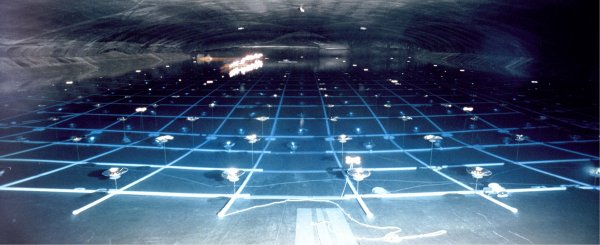
Cosmologists mapping out the origins of high-energy cosmic rays reaching Earth have discovered two unexpected “hotspots”. Their observations are in stark contrast to current theories — which predict that our own galaxy’s magnetic fields should “scramble” incoming cosmic rays , making it look like they come from all directions.
Although the results are puzzling, an explanation for the hotspots could provide insight into the still unexplained origins of some cosmic rays and how they propagate through space.
Cosmic rays are energetic particles consisting mainly of protons, some helium nuclei, and other heavier nuclei. Although first discovered about 100 years ago, it has proven very difficult to pin down where they are coming from. In 2007, researchers at the Pierre Auger Observatory in Argentina found that rare ultra-high energy cosmic rays with energies greater than about 1019 eV were created in the vicinity of black holes at the centre of nearby galaxies.
However, some physicists believed that the origins of the much more common lower-energy TeV (1012eV) cosmic rays would remain a mystery. This is because the paths of charged particles with energies less than about 1018 eV are bent by galactic magnetic fields, as they travel through space, causing them to follow a meandering path that obscures their origin.
Two unexpected hotspots
Now, Milagro — the first observatory capable of continuously monitoring the Northern sky for TeV cosmic rays — has put this in doubt by revealing two cosmic-ray hotspots (Phys. Rev. Lett. 101 221101).
Located in the mountains near Los Alamos National Laboratory in New Mexico, Milagro does not detect comsic rays directly, but rather looks for “air showers” of millions of secondary particles that are created when a cosmic ray collides with a nucleus in the atmosphere. Shower particles are detect in a large pool of water filled with photomultipliers — which detect flashes of light (Cherenkov radiation) that occur when particles pass through the water. Shower data are then analysed to determine the energy and arrival direction of the cosmic ray.
In a seven-year run ending in April 2008, Milagro worked out the direction of over 200 billion cosmic rays with TeV energies. Crucially, it found an excess of cosmic rays arriving from two small isolated regions of the sky, roughly 10 degrees across.
“The most straightforward explanation of this excess – a region of the sky where cosmic rays are produced – could not account for how the cosmic rays reach us without bouncing around and losing any directional information in the process,” explains Allen Mincer at New York University and a member of the Milagro team. One possibility, according to Mincer, is that a special structure of magnetic fields is somehow guiding the cosmic rays from their source to Earth. It is also possible that the cosmic rays are electrically neutral particles such as neutrons, however Mincer points out that neutron lifetime is too short to make this likely.
Cosmologists are puzzled
Other cosmologists are equally mystified by the results. “This is a very strange result as protons should be randomized by the galactic magnetic field,” says Dan Hooper at the Fermi National Accelerator Laboratory in Illinois. “Somehow, a fraction of these particles are coming from one direction and I know of no especially plausible explanation.”
Troy Porter at the University of California, Santa Cruz, also points out that the Milagro researchers have investigated the signal thoroughly and it persists even after they have accounted for all the likely factors that could cause spurious detections, such as atmospheric distortions.
“It is interesting that the direction of the excess signal is in the direction of the tail of the heliosphere — the solar magnetic field,” says Porter. “However, it is hard to know what to make of this, since we don’t expect a lot of material to be concentrated in this region that could interact with ‘normal’ cosmic rays and produce secondary particles such as neutrons that could travel in a straight line to the Earth, thereby accounting for this effect.”
Next generation may give the answer
The Milagro researchers are now looking forward to their proposed next generation experiment — the High Altitude Water Cherenkov experiment (HAWC) in Mexico, which will be at a higher altitude and sensitive to lower energy cosmic rays.
“We are nearing the 100-year anniversary of the discovery of cosmic rays and we still do not have proof of where they come from,” says John Pretz at the Los Alamos National Laboratory in New Mexico. “If these hot spots are due to a source of cosmic rays, then it would be the solution to a 100 year old riddle. It is also exciting because, for the first time, we are starting to see isolated features in the cosmic-ray sky and that can help us understand their origin.”




